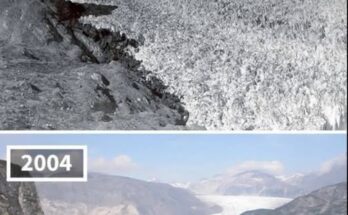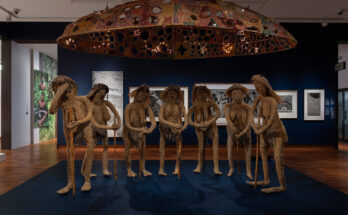Beneath the waves of the North Sea lies a drowned world — a landscape once teeming with life, forests, rivers, and the footsteps of ancient humans. Long before it was covered by water, this vast expanse was part of a landmass known as Doggerland, which connected Britain to mainland Europe. It was here, in this submerged plain, that a remarkable discovery surfaced in 2001 — the partial skull of a young Neanderthal male, now known as Krijn. His fossilized remains, pulled from the seabed off the Dutch coast, are the oldest hominin specimen ever found in the Netherlands and the first from the Pleistocene epoch discovered beneath the sea.
The story of Krijn is more than just the tale of an ancient individual. It is a portal into a forgotten world — one where mammoths roamed, Neanderthals hunted and gathered, and the sea had not yet claimed the lowlands of northern Europe. His discovery bridges archaeology, paleoanthropology, and geology, shedding light on human history at the intersection of land and sea.

The Discovery: A Skull from the Deep
In 2001, a Dutch amateur fossil hunter examining materials dredged from the North Sea near the Zeeland coast stumbled upon a remarkable fragment — part of a hominin skull, specifically a section of the brow ridge and orbital bone. Initial analysis quickly identified the specimen as Neanderthal in origin. This made it the first and only Neanderthal fossil ever recovered from under the sea.
Scientists dated the bone to between 50,000 and 70,000 years ago, placing Krijn’s life in the Middle Paleolithic, during a time when Neanderthals were well-adapted to the frigid climates of Ice Age Europe. The discovery was a triumph for researchers at the Dutch National Museum of Antiquities and the Naturalis Biodiversity Center, both of which worked to conserve, study, and publicize the significance of the find.
The fragment was named “Krijn”, a traditional Dutch name, a symbolic gesture that humanized the fossil and made it relatable to modern audiences. Although only a portion of the skull was recovered, it was enough to inspire years of research — and even a detailed facial reconstruction using modern forensic and anthropological techniques.
Who Was Krijn?
While the fossil remains limited, researchers have been able to draw significant conclusions about Krijn and the world he lived in. He was a young adult male, likely robust and strongly built — features typical of Neanderthals, who were adapted to cold climates with thick bones, broad bodies, and prominent facial features. His brow ridge was pronounced, his eye sockets large, and his skull thick — all traits consistent with other Neanderthal finds across Europe.
Bone isotope analysis revealed clues about Krijn’s diet. He was primarily a meat-eater, hunting large Ice Age mammals like reindeer, bison, or perhaps even woolly mammoths. However, the analysis also detected a marine component, suggesting that Krijn occasionally consumed seafood — a rare but not unprecedented finding in Neanderthal dietary studies.
One striking feature found in Krijn’s skull was a small cavity in the bone above his eye socket, likely a benign tumor, such as an epidermoid cyst. This is the oldest known tumor found in a Neanderthal fossil, offering insight not only into his health but also into the kinds of biological challenges ancient humans faced — ones we still encounter today.
Life in Doggerland
To understand Krijn’s world, one must understand Doggerland, the now-submerged land that once stretched between Britain, the Netherlands, and parts of northern Europe. During the Pleistocene, vast ice sheets periodically locked up enormous quantities of water, causing sea levels to drop by as much as 120 meters. The North Sea was not a sea then — it was a tundra-like steppe, crisscrossed by rivers and rich with flora and fauna.
Doggerland would have been an ideal habitat for Neanderthals like Krijn. It featured a mosaic of ecosystems, from open grasslands for grazing animals to wooded areas for shelter. It was a place of opportunity — for hunting, for gathering plants and berries, for crafting tools, and for migrating along seasonal paths.
Evidence suggests Neanderthals may have occupied this region for thousands of years. The North Sea floor has yielded not just Krijn’s skull fragment, but also stone tools, animal bones, and mammoth tusks, all testifying to the richness of prehistoric life. The land bridge of Doggerland was essential for migration and contact between human populations in western Europe and the British Isles.
Neanderthals: More Than Cavemen
Krijn’s discovery is a reminder of how complex and intelligent Neanderthals truly were. Once depicted as brutish and primitive, Neanderthals are now understood to have had a rich cultural life. They crafted tools using sophisticated techniques, buried their dead with care, and possibly even created art. Recent genetic studies show they interbred with Homo sapiens — meaning many modern humans still carry Neanderthal DNA.
Neanderthals were not a failed offshoot of humanity; they were a successful species in their own right, surviving for over 300,000 years in some of the harshest environments on Earth. Krijn was part of that lineage — a hunter, survivor, and community member whose brief life intersected with a turning point in human history.
The Drowning of Doggerland
Around 8,000 years ago, Doggerland began to vanish. As the last Ice Age ended, melting glaciers raised sea levels, gradually inundating the low-lying plains. Catastrophic events, such as the Storegga Slide, a massive underwater landslide off the coast of Norway, may have triggered sudden tsunamis that accelerated the flooding.
Within a few thousand years, most of Doggerland was underwater, leaving behind only islands — and eventually the outline of the modern North Sea. The people who lived there would have been forced to migrate inland, abandoning a once-thriving homeland to the ocean’s rising tides.
Krijn’s fossil — pulled from the sea floor — is a relic of this drowned world. His preservation is a fluke of geology and fate, an echo of a time when humans still lived in balance with vast ecosystems and unspoiled wilderness.
Reconstructing Krijn
In 2021, to mark the 20th anniversary of the fossil’s discovery, Dutch researchers unveiled a life-sized reconstruction of Krijn’s face. Using cutting-edge forensic anthropology and 3D modeling, artists were able to bring Krijn to life — or at least to offer a visual approximation. The reconstruction shows a young man with strong features, sun-weathered skin, deep-set eyes, and a sense of determined alertness. His expression hints at intelligence and resilience — a face that could have belonged to someone you’d pass on the street, were it not for the vast gulf of time.
This reconstruction, displayed at the National Museum of Antiquities in Leiden, has captivated audiences. Visitors gaze into the eyes of a human ancestor who lived tens of thousands of years ago — a reminder that the story of humanity is not just written in history books but also in bones, sediments, and the sea itself.
Why Krijn Matters
Krijn’s discovery is significant for many reasons. First, it expands our understanding of Neanderthal geography. Fossils have been found across Europe and parts of western Asia, but few have emerged from beneath the sea. Krijn proves that submerged landscapes like Doggerland were once vital corridors for ancient humans.
Second, Krijn’s tumor provides insight into Neanderthal health and pathology, revealing that they, too, suffered from medical conditions we associate with modernity.
Third, Krijn underscores the importance of the North Sea as an archaeological treasure trove. As sea levels continue to rise and human activity on the seabed increases — through dredging, wind farms, and oil exploration — the urgency to protect and study underwater heritage grows.
Finally, Krijn reminds us of our shared humanity. He was not just a fossil but a person — a youth with hopes, fears, and a place in a tight-knit community. His bones connect us to the deep past and challenge us to think about where we come from, and where we are going.
The Future of Undersea Archaeology
Krijn’s skull fragment is just the beginning. Scientists believe thousands of undiscovered artifacts lie buried beneath the North Sea, remnants of a world that existed before the flood. Advances in marine archaeology, such as submersible drones, sonar mapping, and sediment analysis, offer new hope for unlocking the secrets of Doggerland.
In recent years, international projects like Europe’s Lost Frontiers have used seismic surveys and computer modeling to map the drowned landscape in remarkable detail. These efforts aim to reconstruct not only the geography of Doggerland but also its human past — villages, migrations, ecological shifts, and the eventual exodus from the vanishing land.
Each new find adds depth to the story — a flint blade here, a hearth there, a mammoth tusk etched with marks. The discovery of Krijn was a milestone in this journey — a symbol of what we can learn when we look beneath the surface, literally and figuratively.
Conclusion: The Face in the Waves
Krijn the Neanderthal is not just a name in a museum catalog. He is a symbol of endurance, curiosity, and the unbroken chain of human history. Found beneath the cold waters of the North Sea, his face now gazes out at us across tens of millennia, reminding us that our past is not lost — only hidden.
As climate change threatens coastal communities and sea levels rise again, the story of Doggerland and Krijn takes on a new resonance. Once, the sea swallowed a world. Today, as we confront our own environmental challenges, Krijn’s silent testimony urges us to remember — to value the fragile threads that connect us to the Earth, to our ancestors, and to each other.
We are all descendants of wanderers and survivors, shaped by forces larger than ourselves. In the bones of Krijn, we find not just evidence of an extinct species, but a reflection of our own humanity.


